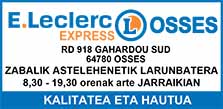Nancy Lofholm. Before a banner reading “Ongi Etorri” — “welcome” in the Basque language — Grand Junction officials, along with Basques from across Colorado, and from California came together over the weekend to celebrate a Basque handball court, the only one of its kind in Colorado and one of only a handful in the nation.
The nearly half-century-old Plaza Urrutia court has been officially established as a state historic site with its inclusion on the Colorado Register of Historic Properties. The designation for the three-sided concrete court that Basques call a fronton was approved last fall, but the official plaque was unveiled at the site Saturday.
“This is a place of belonging for this community,” Grand Junction Mayor Abe Herman said Saturday in his address to the mostly Basque crowd.
“This is just really, really important and special. It’s a prideful thing for me,” said 25-year-old Grand Junction resident Sydney Corra whose Basque mother, Itzaxo Amarica, used to bring her to Plaza Urrutia as a child. Her Basque grandparents, who came to Grand Junction from Guernica, Spain, also found a bit of home at the fronton.
If the nearly half-century-old court had been demolished as planned in the late 1990s, Corra said, “I think it would have crushed my soul.”
Instead of being destroyed to make way for a parking lot, the fronton has become the only site in Colorado officially recognizing the importance of the Basques who started coming to Colorado and Utah a century ago to herd sheep. There are now an estimated 2,200 Basques in Colorado. Very few — if any — still work at herding. Many of those who came as humble herders are now successful businesspeople, civic activists and respected philanthropists.
The late Gene Urruty was one of those. He built Plaza Urrutia on a ranch he owned. His wife, Benerita, donated the land with the fronton on it to the city after his death. The land was turned into a showcase park for Grand Junction.
Canyon View Park quickly became a busy magnet for sports, including soccer, baseball, and volleyball. The handball court which was decorated with sun rays and other Basque symbols to mimic the frontons found in many villages in the Pyrenees mountains between France and Spain, was an incongruous and unnecessary relic in a new manicured park.
At least that’s what city officials thought at the time.
Community rose up to protect the fronton
When word got out that the fronton was going to be razed, the Basque community rose up, and with hundreds of supporters, convinced the city to save the fronton. First-generation Basque Mona Dyer, recalled at Saturday’s celebration that city workers had to shovel manure out of the edifice that had been turned into a sort of landscaping storage place for the park.
Juan Vertiz had tears in his eyes Saturday as he sat in front of a fluttering red, white and green Basque flag with the fronton behind him and the crack of pelota balls punctuating the hum of conversation around him. Pelota is the Basque version of handball, a more hardcore game that is played with rock-hard balls that have left older pelota players with leathery fingers the size of sausages.
Vertiz helped to build the fronton about a decade after he came to the Grand Valley as a teenager in 1964 to herd sheep.
“It was something we had to enjoy ourselves here. I remember playing the first game here,” he said pointing around the gathering at three other Basque men who played with him that day in 1978.
After the older Basque men gave up the demanding game, the court on the park corner remained an oddity or a mystery to some. It became a place for Saturday handball games for non-Basques. Its statewide significance was not recognized until several years ago when the president of the Euskal Extea Colorado Basque Club was driving through Grand Junction and spotted the distinct lines of the fronton.
Marie “Mayi” Berterretche Petracek organized a gathering of the club at the fronton in 2022 that drew Basques from the Front Range and from as far away as California and Mexico to celebrate the existence of a tournament-sized fronton and to play exhibition games of pelota.
National and State Register Historian Eric Newcombe read a story about the fronton celebration in The Colorado Sun and prodded the Basque community and the City of Grand Junction to make an effort to have the edifice designated as a historic site.
Dyer worked with then Grand Junction city planner Kristen Ashbeck to complete an application last summer after they secured local approvals. The History Colorado board then approved the designation.
Another larger celebration at the fronton, which is increasingly recognized as a Basque meeting place for the western United States, is slated for Sept. 21 when the Colorado Basque club will host a North American Basque Organizations meeting in Grand Junction.
Petracek said that gathering will bring more semi-professional pelota players, a Basque priest to bless Plaza Urrutia, Basque dancers from Boise, Idaho, a band and a crew to roast lambs.
As that is being planned, Ashbeck and Petracek are already on another planning track. In 2028, when Plaza Urrutia is 50 years old, it will be eligible for inclusion on the National Register of Historic Places.
Ashbeck said she has retired from her 33-year job as a city planner, but I will keep working with the Basques to make sure that is completed.
“We are not finished yet,” Ashbeck said
For now, Ashbeck’s new job is being a horticulture worker for the city. That means she filled a planter near the fronton with flowers this spring. She will also be installing the new plaque recognizing Plaza Urrutia as a historic site.
The plaque created by a city that once wanted to raze the plaza now recognizes that it is “a beloved and respected symbol of the Basque culture in the Grand Valley and statewide.”



 Lagun bati bidali
Lagun bati bidali Komentarioa gehitu
Komentarioa gehitu








